Simulation of Groundwater-Surface Water Interactions under Different Land Use Scenarios in the Bulang Catchment, Northwest China
Abstract
:1. Introduction
2. Materials and Methods
2.1. Study Area
2.2. Methods
2.2.1. Water Balance
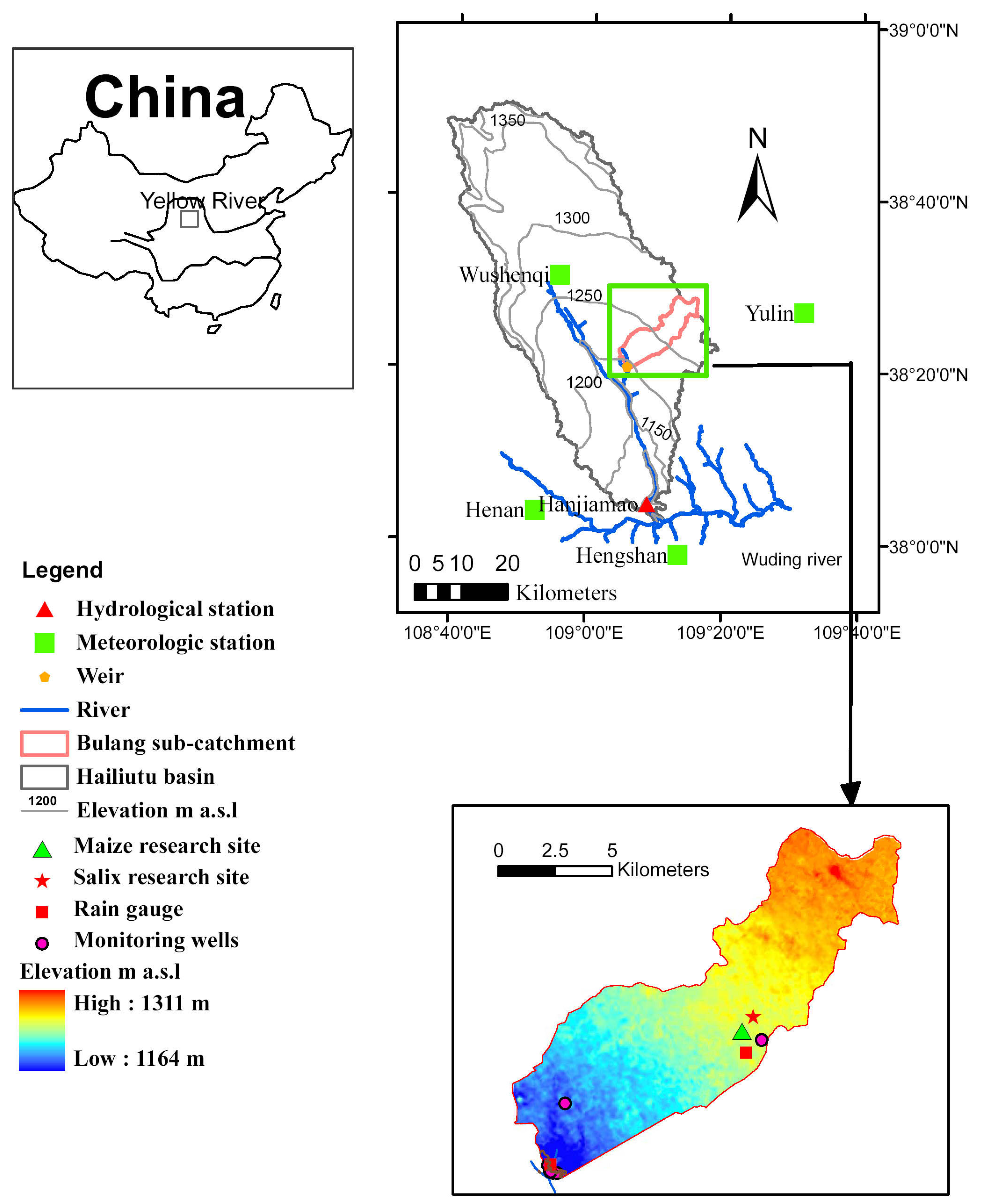
2.2.2. Groundwater Discharge
2.2.3. Groundwater Model
2.2.4. Scenario Analysis
- Scenario 1 assumes a natural situation in which the catchment is covered by desert grasses. This scenario sets up a bench mark case to compare impacts of land use changes on groundwater and stream flow.
- Scenario 2 represents the current land use in 2011. Impacts of current land use changes on groundwater and stream flow can be analyzed by a comparison to scenario 1.
- Scenario 3 simulates effects of replacing maize crops with less water consumptive crops such as sorghum and millet in order to provide support to the policy of extending dry-resistant crops in the area.
- Scenario 4 proposes an ideal land use scenario where sand dunes are covered by desert grasses and dry-resistant crops are grown. This scenario gives direction to the future land use changes in the area.
2.2.5. Model Inputs for the Simulation of Land Use Scenarios
| Scenario | Rainfall | Crop ET | Plant ET | NDVI Map |
|---|---|---|---|---|
| 1-Natural situation | 214.8 | Artemisia Ordosica (133.6) | Artemisia Ordosica (133.6) | August 2011 |
| 2-Current land use | 214.8 | Maize (503.1) | Salix Psammophila (245.1) | August 2011 |
| 3-Dry-resistant crop | 214.8 | Sorghum (402.5) | Salix Psammophila (245.1) | August 2011 |
| 4-Ideal land use | 214.8 | Sorghum (402.5) | Artemisia Ordosica (133.6) | August 2011 |
| Scenario | Rainfall | Crop ET | Plant ET | NDVI Map |
|---|---|---|---|---|
| 2-Current land use | Dry (214.8) | Maize (503.1) | Salix Psammophila (245.1) | August 2011 |
| Normal (340.0) | August 2009 | |||
| Wet (420.0) | September 2014 | |||
| 4-Ideal land use | Dry (214.8) | Sorghum (402.5) | Artemisia Ordosica (133.6) | August 2011 |
| Normal (340.0) | August 2009 | |||
| Wet (420.0) | September 2014 |
2.3. Field Measurements
2.3.1. Precipitation and Evapotranspiration

2.3.2. Discharge Gauge
2.3.3. Observation Wells
3. Results
3.1. Estimation of Water Balance and Groundwater Discharge
3.1.1. Estimation of Catchment Water Balance
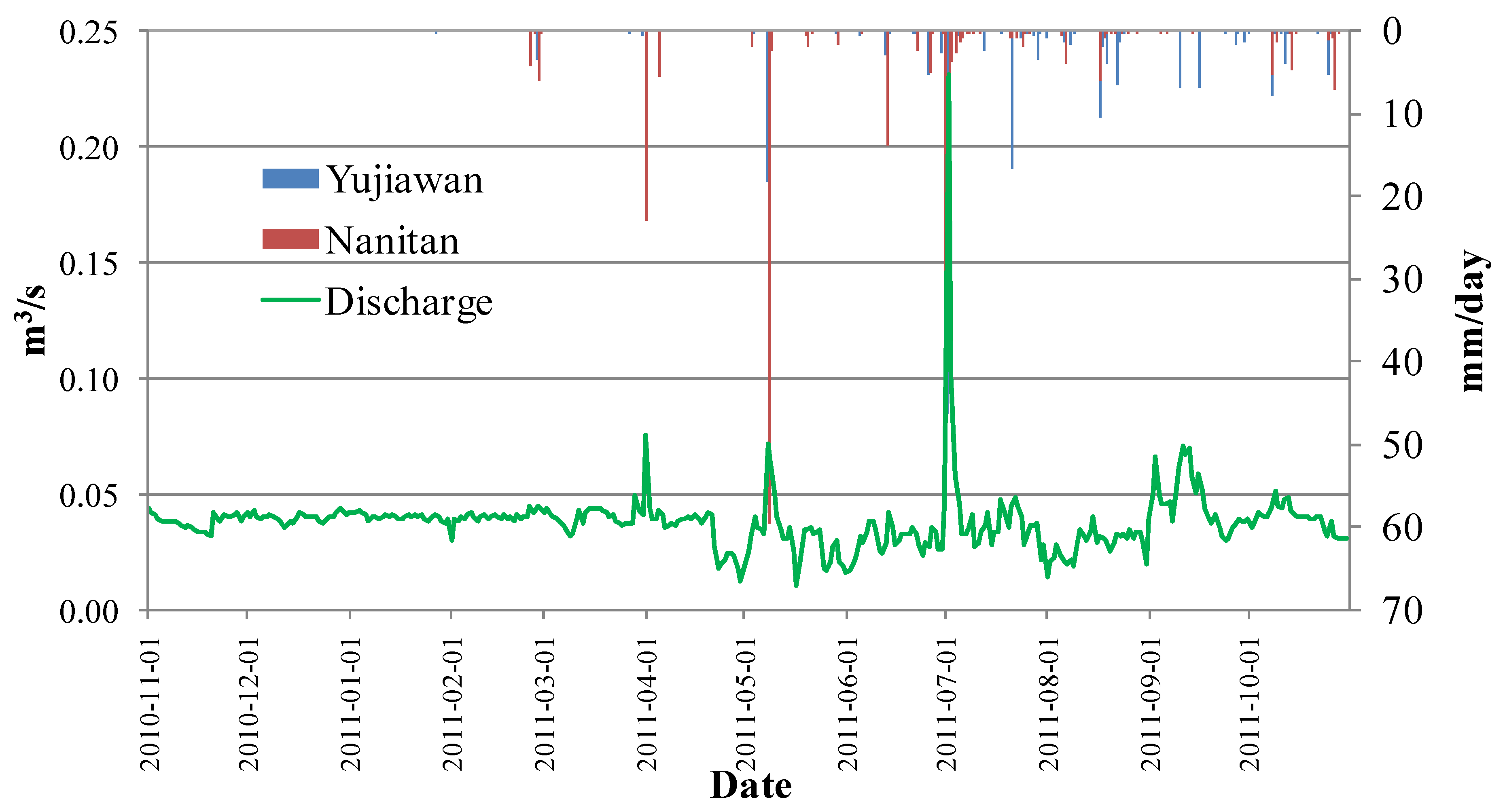
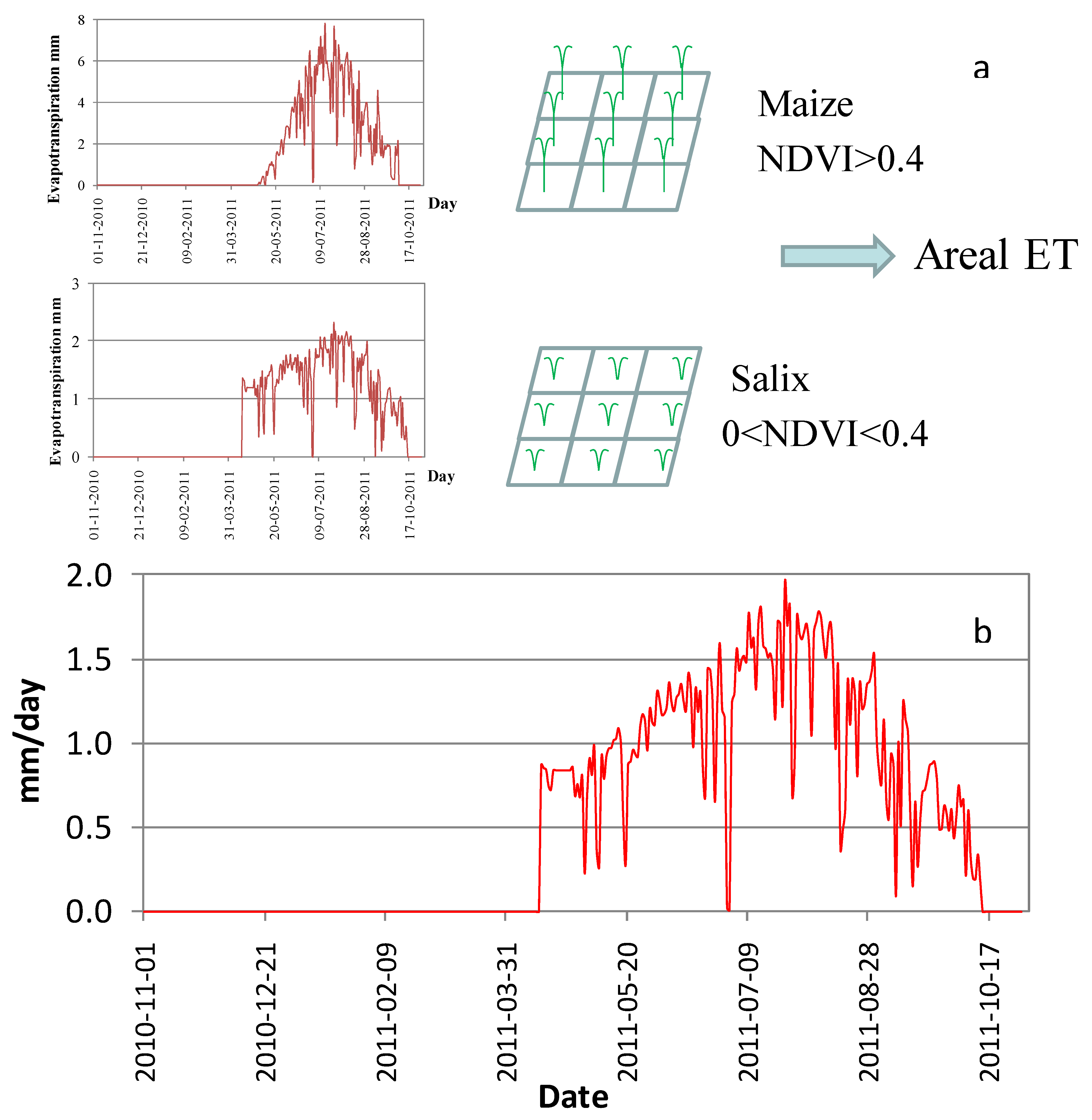

| Estimation method | Precipitation | ET | Net Recharge | Discharge | Deep Circulation | Change of Storage |
|---|---|---|---|---|---|---|
| Water Balance | 214.8 | 196.0 | 18.8 | 12.6 | 6.2 | 0 |
| Steady model | 214.8 | 196.0 | 18.8 | 13.1 | 5.8 | 0 |

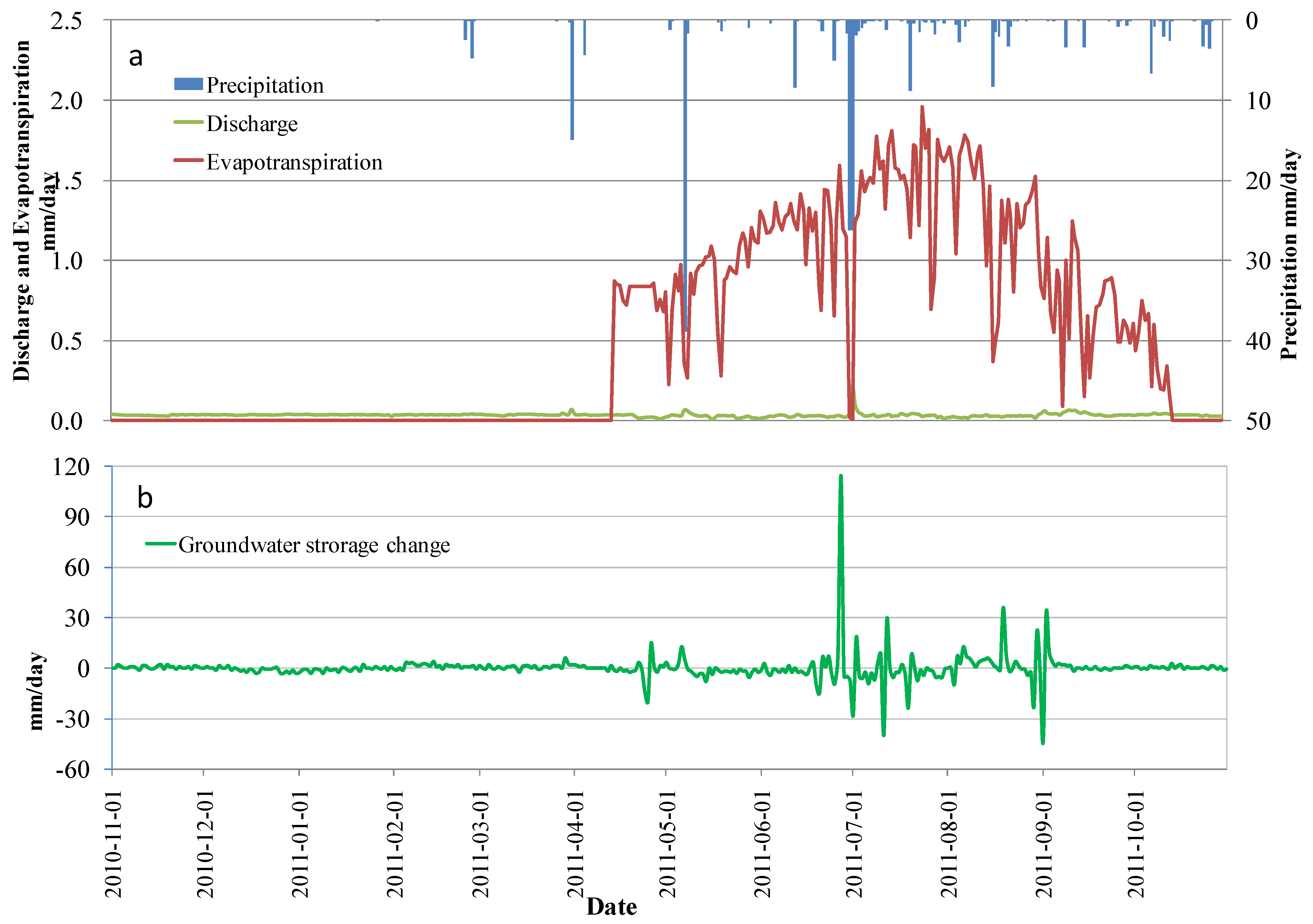
3.1.2. Estimation of Groundwater Discharge
3.2. Calibration of the Groundwater Model
3.2.1. Calibration of the Steady Groundwater Model
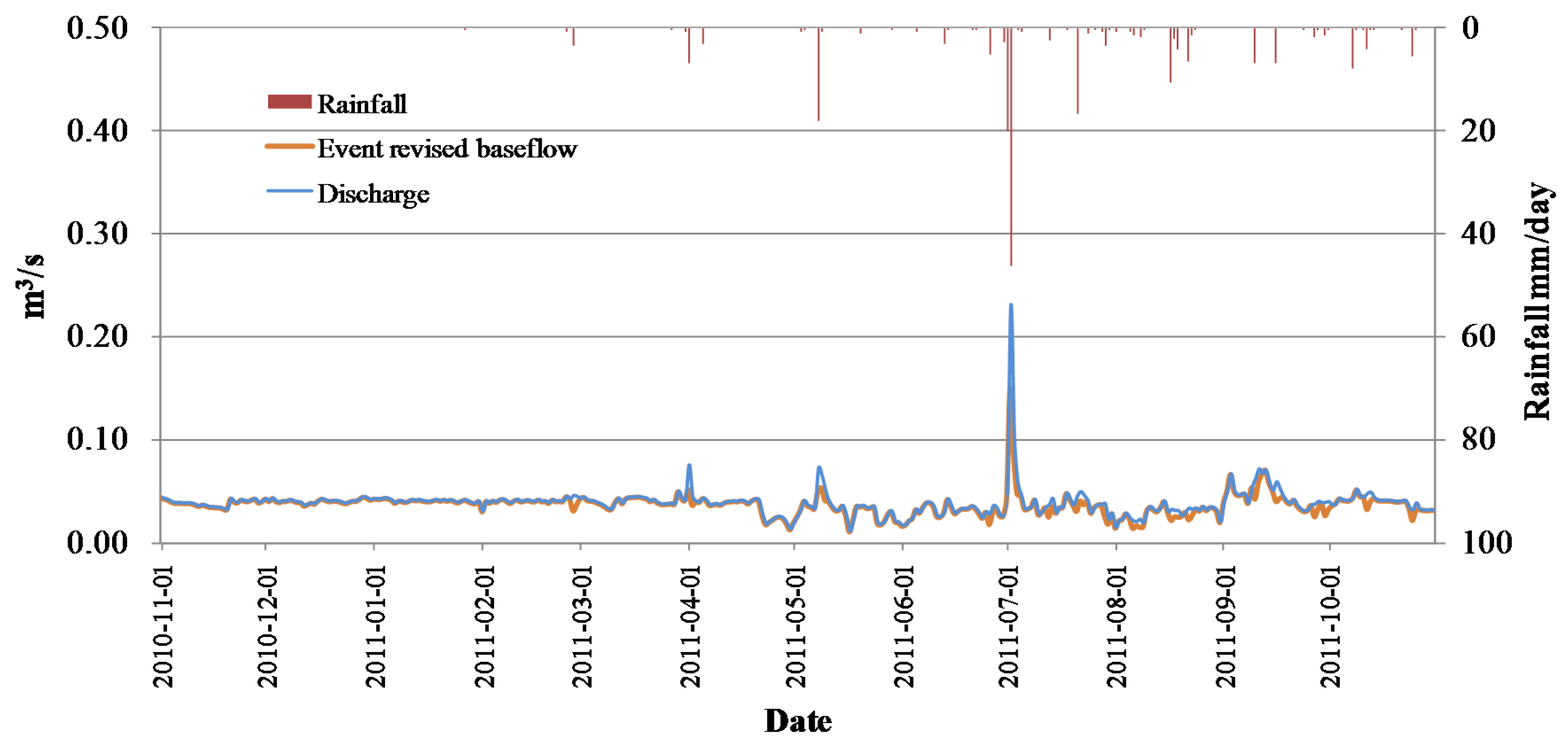
3.2.2. Calibration of the Transient Groundwater Model
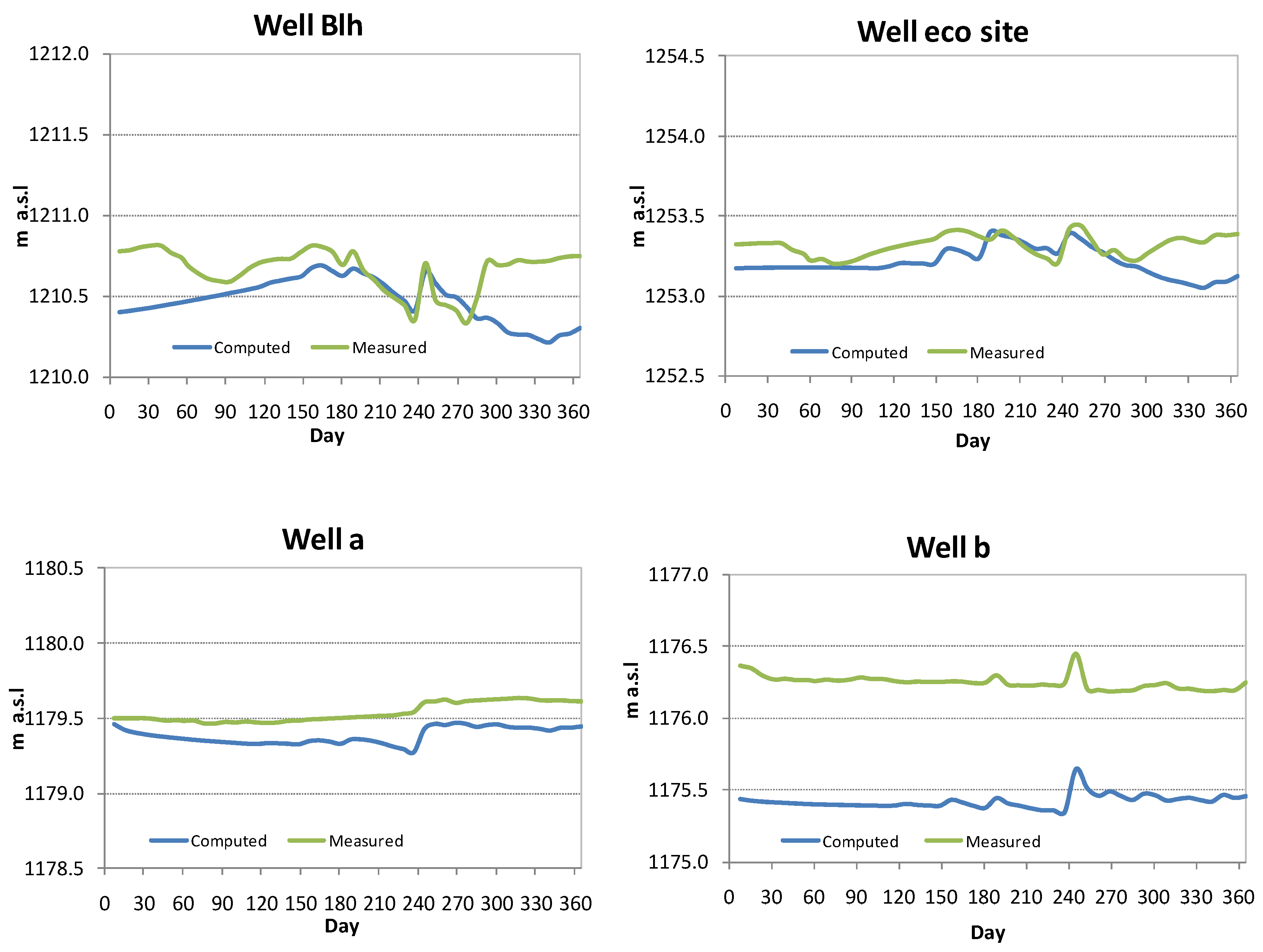

3.2.3. Sensitivity of the Transient Groundwater Model

3.3. Simulation of Land Use Change Scenarios
| Annual Components | Precipitation | ET | Net Recharge | Discharge | Deep Circulation | Change of Storage |
|---|---|---|---|---|---|---|
| Scenario 1 | 214.8 | 102.7 | 112.1 | 13.4 | 8.1 | 90.1 |
| Scenario 2 | 214.8 | 196.0 | 18.8 | 12.7 | 8.0 | −4.1 |
| Scenario 3 | 214.8 | 189.2 | 25.6 | 12.8 | 8.0 | 3.9 |
| Scenario 4 | 214.8 | 120.9 | 93.9 | 13.2 | 8.1 | 72.4 |
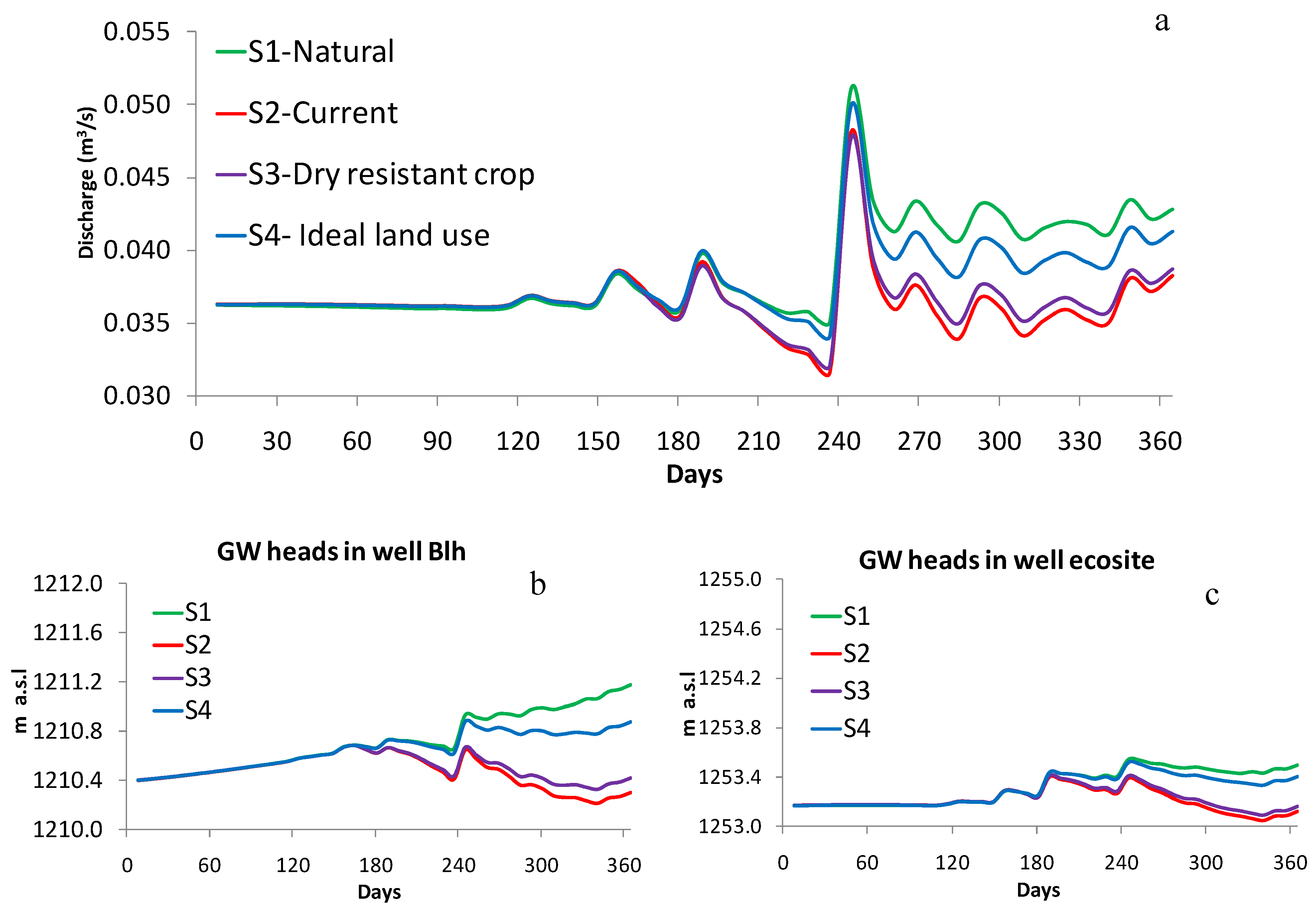

| Annual Components | Precipitation | ET | Net Recharge | Discharge | Deep Circulation | Change of Storage | |
|---|---|---|---|---|---|---|---|
| Scenario 2 | Dry | 214.8 | 196.0 | 18.8 | 12.7 | 8.0 | −4.06 |
| Normal | 340.0 | 218.4 | 121.6 | 13.6 | 8.2 | 99.24 | |
| Wet | 420.0 | 280.5 | 139.5 | 13.8 | 8.4 | 115.86 | |
| Scenario 4 | Dry | 214.8 | 120.9 | 93.9 | 13.2 | 8.1 | 72.4 |
| Normal | 340.0 | 136.7 | 203.3 | 14.1 | 8.3 | 179.9 | |
| Wet | 420.0 | 166.0 | 254.0 | 14.5 | 8.4 | 228.6 | |
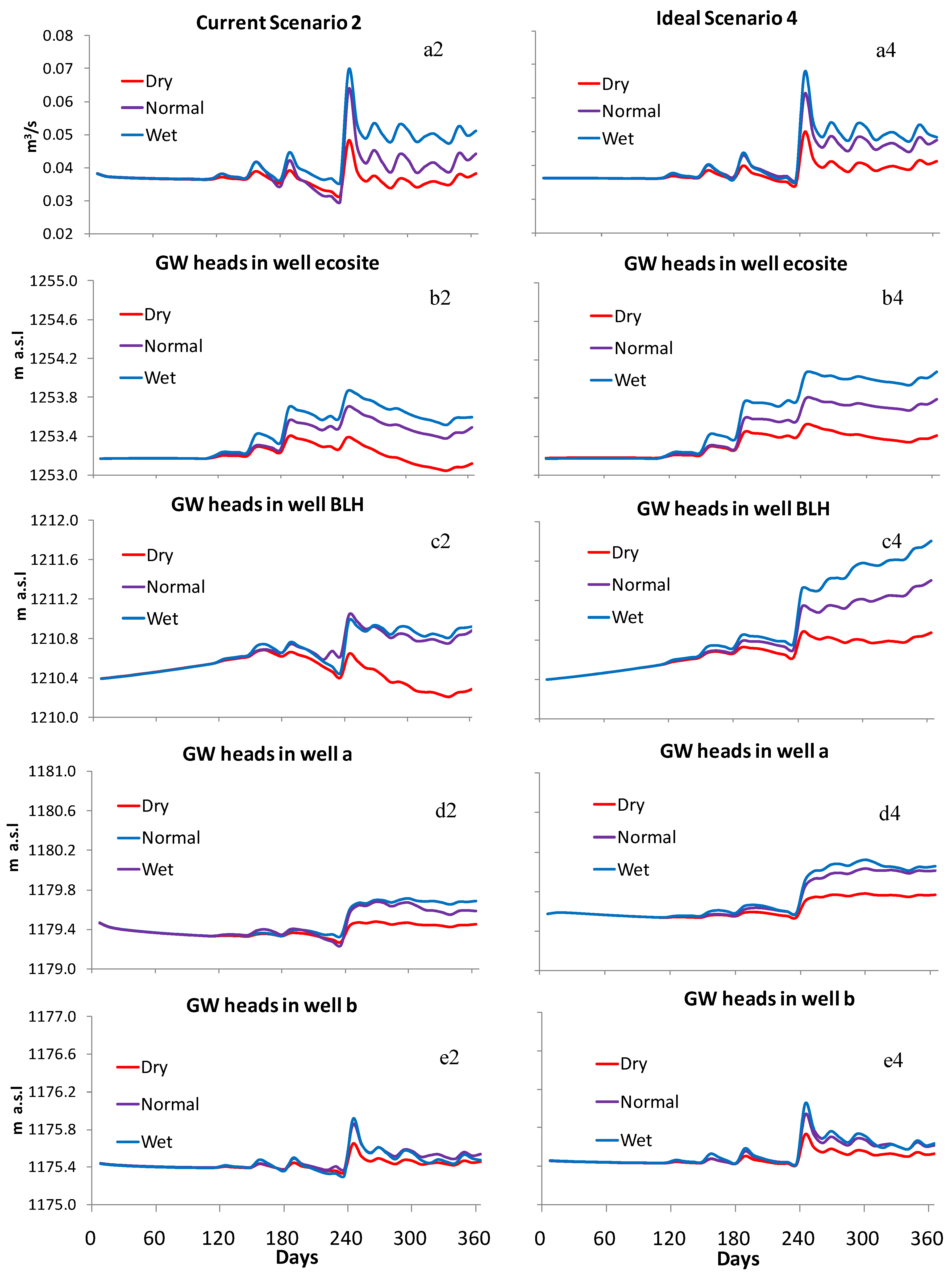
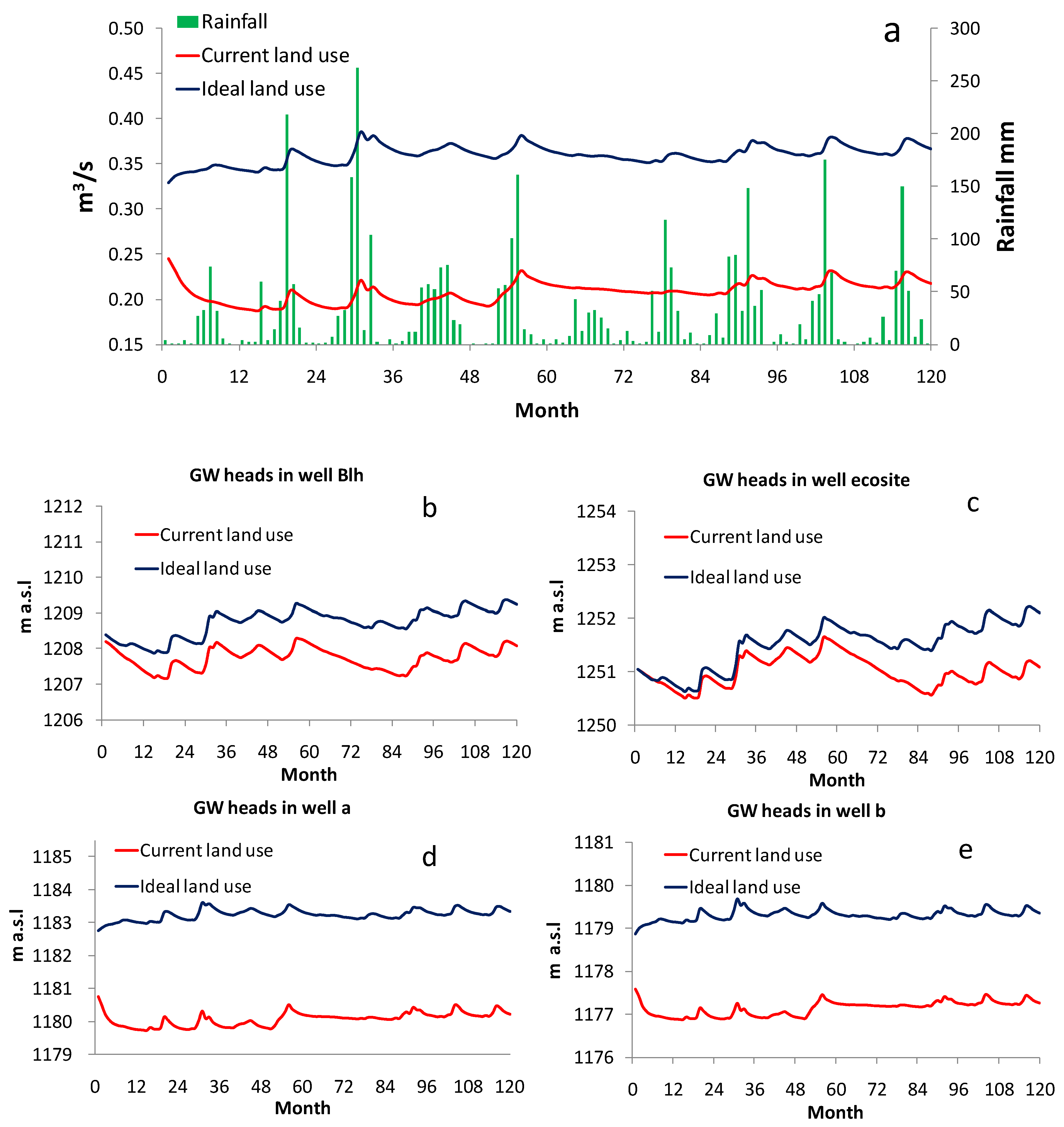
4. Discussions
5. Conclusions
Acknowledgments
Author Contributions
Conflicts of Interest
References
- Snyman, H.; Fouché, H. Production and water-use efficiency of semi-arid grasslands of South Africa as affected by veld condition and rainfall. Water SA 1991, 17, 263–268. [Google Scholar]
- Deng, X.P.; Shan, L.; Zhang, H.; Turner, N.C. Improving agricultural water use efficiency in arid and semiarid areas of China. Agric. Water Manag. 2006, 80, 23–40. [Google Scholar] [CrossRef]
- Mitchell, D.; Fullen, M.; Trueman, I.; Fearnehough, W. Sustainability of reclaimed desertified land in Ningxia, China. J. Arid Environ. 1998, 39, 239–251. [Google Scholar] [CrossRef]
- Bellot, J.; Sanchez, J.; Chirino, E.; Hernandez, N.; Abdelli, F.; Martinez, J. Effect of different vegetation type cover on the soil water balance in semi-arid areas of south eastern Spain. Phys. Chem. Earth Part B: Hydrol. Oceans Atmos. 1999, 24, 353–357. [Google Scholar] [CrossRef]
- Mermoud, A.; Tamini, T.; Yacouba, H. Impacts of different irrigation schedules on the water balance components of an onion crop in a semi-arid zone. Agric. Water Manag. 2005, 77, 282–295. [Google Scholar] [CrossRef]
- Brown, A.E.; Zhang, L.; McMahon, T.A.; Western, A.W.; Vertessy, R.A. A review of paired catchment studies for determining changes in water yield resulting from alterations in vegetation. J. Hydrol. 2005, 310, 28–61. [Google Scholar] [CrossRef]
- Jothityangkoon, C.; Sivapalan, M.; Farmer, D. Process controls of water balance variability in a large semi-arid catchment: Downward approach to hydrological model development. J. Hydrol. 2001, 254, 174–198. [Google Scholar] [CrossRef]
- Farmer, D.; Sivapalan, M.; Jothityangkoon, C. Climate, soil, and vegetation controls upon the variability of water balance in temperate and semiarid landscapes: Downward approach to water balance analysis. Water Resour. Res. 2003, 39. [Google Scholar] [CrossRef]
- Scott, R.L.; James Shuttleworth, W.; Goodrich, D.C.; Maddock, T., III. The water use of two dominant vegetation communities in a semiarid riparian ecosystem. Agric. For. Meteorol. 2000, 105, 241–256. [Google Scholar] [CrossRef]
- Li, Y.; Cui, J.; Zhang, T.; Okuro, T.; Drake, S. Effectiveness of sand-fixing measures on desert land restoration in Kerqin Sandy Land, northern China. Ecol. Eng. 2009, 35, 118–127. [Google Scholar] [CrossRef]
- Zhang, L.; Dawes, W.; Walker, G. Response of mean annual evapotranspiration to vegetation changes at catchment scale. Water Resour. Res. 2001, 37, 701–708. [Google Scholar] [CrossRef]
- Lørup, J.K.; Refsgaard, J.C.; Mazvimavi, D. Assessing the effect of land use change on catchment runoff by combined use of statistical tests and hydrological modelling: Case studies from Zimbabwe. J. Hydrol. 1998, 205, 147–163. [Google Scholar] [CrossRef]
- Bronstert, A.; Niehoff, D.; Bürger, G. Effects of climate and land-use change on storm runoff generation: Present knowledge and modelling capabilities. Hydrol. Process. 2002, 16, 509–529. [Google Scholar] [CrossRef]
- Niehoff, D.; Fritsch, U.; Bronstert, A. Land-use impacts on storm-runoff generation: Scenarios of land-use change and simulation of hydrological response in a meso-scale catchment in SW-Germany. J. Hydrol. 2002, 267, 80–93. [Google Scholar] [CrossRef]
- Yang, Z.; Zhou, Y.; Wenninger, J.; Uhlenbrook, S. The causes of flow regime shifts in the semi-arid Hailiutu River, Northwest China. Hydrol. Earth Syst. Sci. 2012, 16, 87–103. [Google Scholar] [CrossRef]
- Ahearn, D.S.; Sheibley, R.W.; Dahlgren, R.A.; Anderson, M.; Johnson, J.; Tate, K.W. Land use and land cover influence on water quality in the last free-flowing river draining the western Sierra Nevada, California. J. Hydrol. 2005, 313, 234–247. [Google Scholar] [CrossRef]
- Zampella, R.A.; Procopio, N.A.; Lathrop, R.G.; Dow, C.L. Relationship of land-use/land-cover patterns and surface-water quality in the mullica river Basin1. J. Am. Water Resour. Assoc. 2007, 43, 594–604. [Google Scholar] [CrossRef]
- Harbor, J.M. A practical method for estimating the impact of land-use change on surface runoff, groundwater recharge and wetland hydrology. J. Am. Water Resour. Assoc. 1994, 60, 95–108. [Google Scholar] [CrossRef]
- Scanlon, B.R.; Reedy, R.C.; Stonestrom, D.A.; Prudic, D.E.; Dennehy, K.F. Impact of land use and land cover change on groundwater recharge and quality in the southwestern US. Glob. Chang. Biol. 2005, 11, 1577–1593. [Google Scholar] [CrossRef]
- Salama, R.; Hatton, T.; Dawes, W. Predicting land use impacts on regional scale groundwater recharge and discharge. J. Environ. Qual. 1999, 28, 446–460. [Google Scholar] [CrossRef]
- Batelaan, O.; De Smedt, F.; Triest, L. Regional groundwater discharge: Phreatophyte mapping, groundwater modelling and impact analysis of land-use change. J. Hydrol. 2003, 275, 86–108. [Google Scholar] [CrossRef]
- Furukawa, Y.; Inubushi, K.; Ali, M.; Itang, A.; Tsuruta, H. Effect of changing groundwater levels caused by land-use changes on greenhouse gas fluxes from tropical peat lands. Nutr. Cycl. Agroecosyst. 2005, 71, 81–91. [Google Scholar] [CrossRef]
- Jeong, C.H. Effect of land use and urbanization on hydrochemistry and contamination of groundwater from Taejon area, Korea. J. Hydrol. 2001, 253, 194–210. [Google Scholar] [CrossRef]
- McLay, C.; Dragten, R.; Sparling, G.; Selvarajah, N. Predicting groundwater nitrate concentrations in a region of mixed agricultural land use: A comparison of three approaches. Environ. Pollut. 2001, 115, 191–204. [Google Scholar] [CrossRef]
- Molénat, J.; Gascuel-Odoux, C. Modelling flow and nitrate transport in groundwater for the prediction of water travel times and of consequences of land use evolution on water quality. Hydrol. Process. 2002, 16, 479–492. [Google Scholar] [CrossRef]
- Cole, M.L.; Kroeger, K.D.; McClelland, J.W.; Valiela, I. Effects of watershed land use on nitrogen concentrations and δ 15 nitrogen in groundwater. Biogeochemistry 2006, 77, 199–215. [Google Scholar] [CrossRef]
- Choi, W.J.; Han, G.H.; Lee, S.M.; Lee, G.T.; Yoon, K.S.; Choi, S.M.; Ro, H.M. Impact of land-use types on nitrate concentration and δ15 N in unconfined groundwater in rural areas of Korea. Agric. Ecosyst. Environ. 2007, 120, 259–268. [Google Scholar] [CrossRef]
- Krause, S.; Jacobs, J.; Bronstert, A. Modelling the impacts of land-use and drainage density on the water balance of a lowland–floodplain landscape in northeast Germany. Ecol. Model. 2007, 200, 475–492. [Google Scholar] [CrossRef]
- Leblanc, M.; Favreau, G.; Tweed, S.; Leduc, C.; Razack, M.; Mofor, L. Remote sensing for groundwater modelling in large semiarid areas: Lake Chad Basin, Africa. Hydrogeol. J. 2007, 15, 97–100. [Google Scholar] [CrossRef] [Green Version]
- Courault, D.; Seguin, B.; Olioso, A. Review on estimation of evapotranspiration from remote sensing data: From empirical to numerical modeling approaches. Irrig. Drain. Syst. 2005, 19, 223–249. [Google Scholar] [CrossRef]
- Waters, P.; Greenbaum, D.; Smart, P.L.; Osmaston, H. Applications of remote sensing to groundwater hydrology. Remote Sens. Rev. 1990, 4, 223–264. [Google Scholar] [CrossRef]
- Sener, E.; Davraz, A.; Ozcelik, M. An integration of GIS and remote sensing in groundwater investigations: A case study in Burdur, Turkey. Hydrogeol. J. 2005, 13, 826–834. [Google Scholar] [CrossRef]
- Münch, Z.; Conrad, J. Remote sensing and GIS based determination of groundwater dependent ecosystems in the Western Cape, South Africa. Hydrogeol. J. 2007, 15, 19–28. [Google Scholar] [CrossRef]
- Shaban, A.; Khawlie, M.; Abdallah, C. Use of remote sensing and GIS to determine recharge potential zones: The case of Occidental Lebanon. Hydrogeol. J. 2006, 14, 433–443. [Google Scholar] [CrossRef]
- Tweed, S.O.; Leblanc, M.; Webb, J.A.; Lubczynski, M.W. Remote sensing and GIS for mapping groundwater recharge and discharge areas in salinity prone catchments, southeastern Australia. Hydrogeol. J. 2007, 15, 75–96. [Google Scholar] [CrossRef]
- Bobba, A.; Bukata, R.; Jerome, J. Digitally processed satellite data as a tool in detecting potential groundwater flow systems. J. Hydrol. 1992, 131, 25–62. [Google Scholar] [CrossRef]
- Ben-Dor, E.; Goldshleger, N.; Braun, O.; Kindel, B.; Goetz, A.; Bonfil, D.; Margalit, N.; Binaymini, Y.; Karnieli, A.; Agassi, M. Monitoring infiltration rates in semiarid soils using airborne hyperspectral technology. Int. J. Remote Sens. 2004, 25, 2607–2624. [Google Scholar] [CrossRef]
- Kalma, J.D.; McVicar, T.R.; McCabe, M.F. Estimating land surface evaporation: A review of methods using remotely sensed surface temperature data. Surv. Geophys. 2008, 29, 421–469. [Google Scholar] [CrossRef]
- Groeneveld, D.P.; Baugh, W.M.; Sanderson, J.S.; Cooper, D.J. Annual groundwater evapotranspiration mapped from single satellite scenes. J. Hydrol. 2007, 344, 146–156. [Google Scholar] [CrossRef]
- Groeneveld, D.P. Remotely-sensed groundwater evapotranspiration from alkali scrub affected by declining water table. J. Hydrol. 2008, 358, 294–303. [Google Scholar] [CrossRef]
- Jin, X.; Wan, L.; Zhang, Y.; Xue, Z.; Yin, Y. A study of the relationship between vegetation growth and groundwater in the Yinchuan Plain. Earth Sci. Front. 2007, 14, 197–203. [Google Scholar] [CrossRef]
- Jin, X.M.; Schaepman, M.E.; Clevers, J.G.; Su, Z.B.; Hu, G. Groundwater depth and vegetation in the Ejina area, China. Arid Land Res. Manag. 2011, 25, 194–199. [Google Scholar] [CrossRef]
- Lv, J.; Wang, X.S.; Zhou, Y.; Qian, K.; Wan, L.; Eamus, D.; Tao, Z. Groundwater-dependent distribution of vegetation in Hailiutu River catchment, a semi-arid region in China. Ecohydrology 2013, 6, 142–149. [Google Scholar] [CrossRef]
- Zhou, Y.; Wenninger, J.; Yang, Z.; Yin, L.; Huang, J.; Hou, L.; Wang, X.; Zhang, D.; Uhlenbrook, S. Groundwater—Surface water interactions, vegetation dependencies and implications for water resources management in the semi-arid Hailiutu River catchment, China—A synthesis. Hydrol. Earth Syst. Sci. 2013, 17, 2435–2447. [Google Scholar] [CrossRef]
- Lubczynski, M.W.; Gurwin, J. Integration of various data sources for transient groundwater modeling with spatio-temporally variable fluxes—Sardon study case, Spain. J. Hydrol. 2005, 306, 71–96. [Google Scholar] [CrossRef]
- Bethenod, O.; Katerji, N.; Goujet, R.; Bertolini, J.; Rana, G. Determination and validation of corn crop transpirationby sap flow measurement under field conditions. Theor. Appl. Climatol. 2000, 67, 153–160. [Google Scholar] [CrossRef]
- Ford, C.R.; Hubbard, R.M.; Kloeppel, B.D.; Vose, J.M. A comparison of sap flux-based evapotranspiration estimates with catchment-scale water balance. Agric. For. Meteorol. 2007, 145, 176–185. [Google Scholar] [CrossRef]
- Stisen, S.; Jensen, K.H.; Sandholt, I.; Grimes, D.I. A remote sensing driven distributed hydrological model of the Senegal River basin. J. Hydrol. 2008, 354, 131–148. [Google Scholar] [CrossRef]
- Hendricks Franssen, H.; Brunner, P.; Makobo, P.; Kinzelbach, W. Equally likely inverse solutions to a groundwater flow problem including pattern information from remote sensing images. Water Resour. Res. 2008, 44. [Google Scholar] [CrossRef]
- Li, H.; Brunner, P.; Kinzelbach, W.; Li, W.; Dong, X. Calibration of a groundwater model using pattern information from remote sensing data. J. Hydrol. 2009, 377, 120–130. [Google Scholar] [CrossRef]
- Yang, Z.; Zhou, Y.; Wenninger, J.; Uhlenbrook, S. A multi-method approach to quantify groundwater/surface water-interactions in the semi-arid Hailiutu River basin, northwest China. Hydrogeol. J. 2014, 22, 527–541. [Google Scholar] [CrossRef]
- McDonald, M.G.; Harbaugh, A.W. A Modular Three-Dimensional Finite-Difference Ground-Water Flow Model; Scientific Publications Company: Reston, VA, USA, 1984. [Google Scholar]
- Doherty, J.; Brebber, L.; Whyte, P. PEST: Model-Independent Parameter Estimation; Watermark Computing: Corinda, Australia, 1994. [Google Scholar]
- Hou, L.; Wenninger, J.; Shen, J.; Zhou, Y.; Bao, H.; Liu, H. Assessing crop coefficients for Zea mays in the semi-arid Hailiutu River catchment, northwest China. Agric. Water Manag. 2014, 140, 37–47. [Google Scholar] [CrossRef]
- Xuejun, D.; Xinshi, Z.; Baozhen, Y. A preliminary study on the water balance for some sand land shrubs based on transpiration measurements in field condition. Acta Phytoecol. Sin. 1997, 21, 208–225. [Google Scholar]
- Huang, J.; Zhou, Y.; Yin, L.; Wenninger, J.; Zhang, J.; Hou, G.; Zhang, E.; Uhlenbrook, S. Climatic controls on sap flow dynamics and used water sources of Salix psammophila in a semi-arid environment in northwest China. Environ. Earth Sci. 2015, 73, 289–301. [Google Scholar] [CrossRef]
- Yang, Z.; Li, X.; Sun, Y.; Liu, L.; Zhang, X.; Ma, Y. Characteristics of rainfall interception and stemflow for Salix Psammophila in Maowusu sandland, Northwest China. Adv. Water Sci. 2008, 19, 693–698. [Google Scholar]
- Lin, D.J.; Zheng, Z.C.; Zhang, X.Z.; LI, T.X.; Wang, Y.D. Study on the effect of maize plants on rainfall redistribution processes. Sci. Agric. Sin. 2011, 44, 2608–2615. [Google Scholar]
- Mu, Q.; Zhao, M.; Running, S.W. Improvements to a MODIS global terrestrial evapotranspiration algorithm. Remote Sens. Environ. 2011, 115, 1781–1800. [Google Scholar] [CrossRef]
- Yangxiao, Z.; Zhi, Y.; Danrong, Z.; Xiaomei , J.; Jun, Z. Inter-catchment comparison of flow regime between the Hailiutu and Huangfuchuan rivers in the semi-arid Erdos Plateau, Northwest China. Sci. J. 2015, 60, 688–705. [Google Scholar]
- Zhao, X.; Jia, Z.; Liu, H.; Song, T.; Wang, Y.; Shi, L.; Song, C.; Wang, Y. Effects of the conversion of marshland to cropland on water and energy exchanges in northeastern China. J. Hydrol. 2008, 355, 181–191. [Google Scholar] [CrossRef]
- Yin, L.; Zhou, Y.; Huang, J.; Wenninger, J.; Zhang, E.; Hou, G. Interaction between groundwater and trees in an arid site: Potential impacts of climate variation and groundwater abstraction on trees. J. Hydrol. 2015, 528, 435–448. [Google Scholar] [CrossRef]
© 2015 by the authors; licensee MDPI, Basel, Switzerland. This article is an open access article distributed under the terms and conditions of the Creative Commons Attribution license (http://creativecommons.org/licenses/by/4.0/).
Share and Cite
Yang, Z.; Zhou, Y.; Wenninger, J.; Uhlenbrook, S.; Wan, L. Simulation of Groundwater-Surface Water Interactions under Different Land Use Scenarios in the Bulang Catchment, Northwest China. Water 2015, 7, 5959-5985. https://doi.org/10.3390/w7115959
Yang Z, Zhou Y, Wenninger J, Uhlenbrook S, Wan L. Simulation of Groundwater-Surface Water Interactions under Different Land Use Scenarios in the Bulang Catchment, Northwest China. Water. 2015; 7(11):5959-5985. https://doi.org/10.3390/w7115959
Chicago/Turabian StyleYang, Zhi, Yangxiao Zhou, Jochen Wenninger, Stefan Uhlenbrook, and Li Wan. 2015. "Simulation of Groundwater-Surface Water Interactions under Different Land Use Scenarios in the Bulang Catchment, Northwest China" Water 7, no. 11: 5959-5985. https://doi.org/10.3390/w7115959






